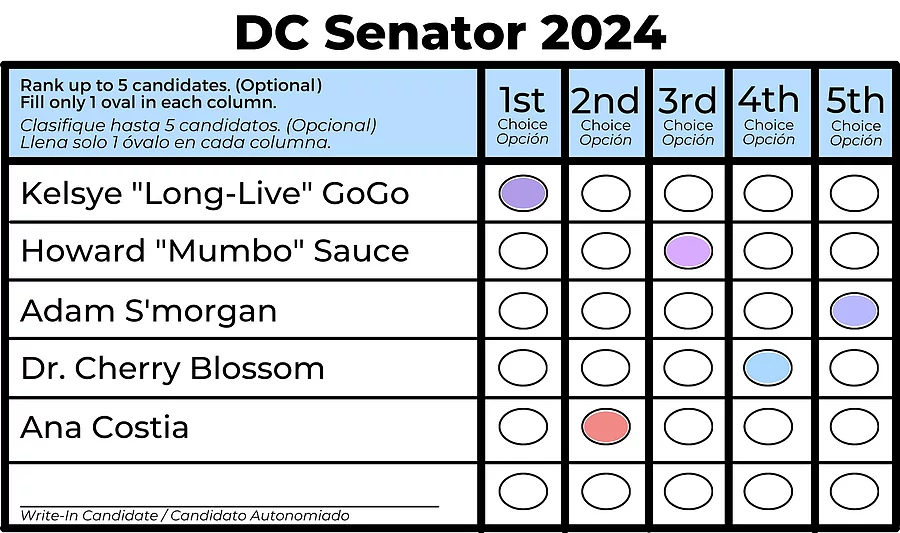A solution for DC's election problems
Problems with DC’s current election system:
- DC voters are told to “hold their nose” and vote for candidates perceived to be winners instead of voting for who will represent them best. Instead of campaigns focused on issues and equity, campaigns focus on who is “electable”.
- Communities end up splitting their vote between similar candidates, weakening their collective voting power. Politicians can then pit people against one another instead of doing the hard work to bring us together.
- Candidates can win even if most voters voted for someone else (for example, in a crowded field, the winner often ends up with less than 50% of the vote). This can result in a winner that most voters don’t support.
An equitable election solution: Ranked Voting
- Washingtonians are free to vote their values and choose a candidate who will represent their community best without needing to worry about “who will win”. This gives voters more choice, voice, and power in the process.
- Diverse communities can build community power together without vote splitting. Politicians are incentivized to bridge our communities, campaign across the city, and build coalitions that reflect the will of the people.
- Fairer and more equitable representation of our communities because candidates have to get a majority of the vote. More voices are heard and more people get to vote for a winner.
How ranked voting works:
Voters are free to vote for their favorite candidate, and they also have the power to rank their backup choices (2nd, 3rd, 4th, 5th) if they’d like.
If your 1st choice is in last place, your vote automatically goes to your next choice. This continues until someone wins over 50% of the vote.
Some extra benefits:
- Tends to elect more women and people of color
- It reduces strategic voting and pressure to vote for the ‘devil you know’.
- Ranking is natural and easy to understand.
- Helps dissolve toxic or negative campaigning
- Makes city-wide politicians have to campaign beyond their base and across the city, forcing them to go East of the River to build broad coalitions.
- Ranking preserves Native Washingtonian voting power and combats political displacement by letting communities vote for backup choices without harming their first choice. When they implemented ranked voting in Oakland, CA, Black representation was maintained despite severe gentrification and population loss.
- Candidates have to build a coalition that includes 1st and 2nd choices (you can't win with only 2nd choice votes).
Example DC Ranked Ballot:

Overview Video:
More Details on How Ranked Ballots Are Counted by the Board of Elections:
Ranked voting is also called Ranked Choice Voting (RCV) or Instant Runoff Voting (IRV). The multi-winner version of ranked voting (what DC would use for our At-Large general elections) is called Proportional Ranked Choice Voting (PRCV) or Single-Transferable Vote (STV).
How At-Large DC Council ranked voting works (2 seats):
For DC voters, it's exactly the same. You have the power to rank your preferences up to 5 in order to elect 2 At-Large Councilmembers in the general election.
For the Board of Elections (BoE), they use proportional representation so our community is best represented by the 2 winners. The BoE makes two small changes from regular ranked voting to most fairly count the votes:
a “majority” changes from 50% to 33% if we're electing 2 people in the same election
to determine the second winner, the BoE needs to account for the second choices of the people whose first choice won. The BoE gives a representative portion of the winning vote to those voters’ backup choices
Otherwise, it’s exactly the same as single-winner ranked voting.